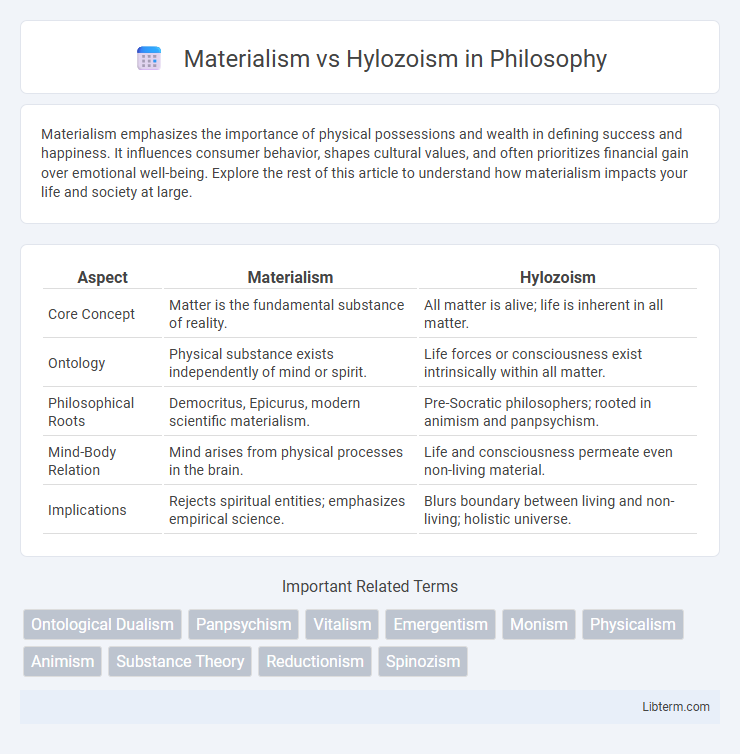Materialism emphasizes the importance of physical possessions and wealth in defining success and happiness. It influences consumer behavior, shapes cultural values, and often prioritizes financial gain over emotional well-being. Explore the rest of this article to understand how materialism impacts your life and society at large.
Table of Comparison
| Aspect | Materialism | Hylozoism |
|---|---|---|
| Core Concept | Matter is the fundamental substance of reality. | All matter is alive; life is inherent in all matter. |
| Ontology | Physical substance exists independently of mind or spirit. | Life forces or consciousness exist intrinsically within all matter. |
| Philosophical Roots | Democritus, Epicurus, modern scientific materialism. | Pre-Socratic philosophers; rooted in animism and panpsychism. |
| Mind-Body Relation | Mind arises from physical processes in the brain. | Life and consciousness permeate even non-living material. |
| Implications | Rejects spiritual entities; emphasizes empirical science. | Blurs boundary between living and non-living; holistic universe. |
Introduction to Materialism and Hylozoism
Materialism asserts that matter is the fundamental substance in nature, and all phenomena, including consciousness and thought, result from material interactions. Hylozoism, by contrast, posits that all matter possesses life or a form of animacy, blurring the distinction between living and non-living entities. These philosophical views offer distinct perspectives on the nature of reality and the underlying essence of existence.
Historical Development of Materialism
Materialism's historical development traces back to ancient Greek philosophers like Democritus and Epicurus, who posited that matter is the fundamental substance of reality. During the Enlightenment, thinkers such as Thomas Hobbes and Julien Offray de La Mettrie advanced materialism by emphasizing mechanistic interpretations of nature and human beings. The 19th century saw materialism evolve with scientific progress, notably through Karl Marx's dialectical materialism, which linked material conditions to societal change.
Origins and Evolution of Hylozoism
Hylozoism originated in ancient Greek philosophy, notably in the works of pre-Socratic thinkers like Thales and Anaximenes, who posited that all matter possesses life or consciousness. This idea evolved through Neoplatonic and Stoic traditions, blending material substance with inherent vitality, contrasting with strict materialism, which asserts that matter is inert and life arises from physical interactions alone. Over time, hylozoism influenced various metaphysical and scientific frameworks, proposing a continuum between living and non-living matter that challenges purely mechanistic views of existence.
Core Principles of Materialism
Materialism asserts that physical matter is the fundamental substance of reality, where all phenomena, including consciousness and thought, emerge from material interactions. It denies the existence of any non-material entities, emphasizing that everything can be explained through physical processes and laws. This core principle contrasts with Hylozoism, which posits a form of universal life or consciousness inherent in all matter.
Fundamental Concepts in Hylozoism
Hylozoism posits that all matter possesses life or consciousness, fundamentally opposing materialism's view of inert matter. It emphasizes the unity of life and matter, suggesting that vitality is an intrinsic property of the physical world. Central concepts include the continuous vitality of all substances and the rejection of a strict dichotomy between living and non-living entities.
Key Philosophers: Materialism vs Hylozoism
Materialism, championed by philosophers such as Democritus and Epicurus, asserts that all phenomena arise from physical matter and its interactions, emphasizing a universe governed by material substances. In contrast, Hylozoism, supported by thinkers like Thales and Anaximenes, posits that all matter possesses life or consciousness, blurring the line between living and non-living entities. The debate highlights fundamental views on the nature of existence, with materialism grounding reality in tangible matter and hylozoism attributing vitality to the very fabric of the physical world.
Consciousness and Mind: Divergent Perspectives
Materialism posits that consciousness and mind emerge solely from physical processes within the brain, emphasizing neural activities and biochemical interactions as the foundation of mental states. Hylozoism, by contrast, attributes a form of inherent vitality or consciousness to all matter, suggesting that consciousness is a fundamental property permeating the universe rather than an emergent phenomenon. These divergent perspectives frame consciousness either as a byproduct of complex material configurations or as an intrinsic quality of all substance, influencing debates in philosophy of mind and cognitive science.
Material World vs Living Universe
Materialism asserts that the material world consists solely of physical substances and processes, emphasizing matter's primacy and denying inherent life or consciousness. Hylozoism posits that the entire universe is alive, attributing vitality and animacy to all matter, thus blurring the boundary between living organisms and the material domain. This contrast highlights fundamental differences in understanding the nature of existence: inert matter governed by physical laws versus a living universe infused with intrinsic vitality.
Scientific Implications and Critiques
Materialism, founded on the premise that only matter and physical phenomena exist, drives scientific inquiry through empirical observation and experimentation, enabling advancements in physics, chemistry, and biology. Hylozoism, which posits that all matter has life or a form of consciousness, challenges conventional scientific paradigms by suggesting intrinsic vitality in inanimate objects, often leading to critiques around its lack of falsifiability and empirical evidence. Scientific critiques emphasize materialism's measurable framework as essential for technological progress, while hylozoism is frequently dismissed for its metaphysical assumptions that complicate testability and objective validation.
Contemporary Relevance and Future Debates
Materialism, emphasizing physical matter as the fundamental substance, dominates contemporary scientific paradigms, shaping advances in neuroscience and artificial intelligence, while hylozoism, proposing life or consciousness as intrinsic to all matter, challenges conventional materialist assumptions and inspires emerging fields like panpsychism. The future debate hinges on integrating quantum mechanics and consciousness studies, potentially redefining the nature of reality and artificial life. These discussions influence ethical considerations in biotechnology, environmental philosophy, and the development of sentient machines, highlighting a resurgence of hylozoistic ideas in contemporary ontology.
Materialism Infographic

 libterm.com
libterm.com